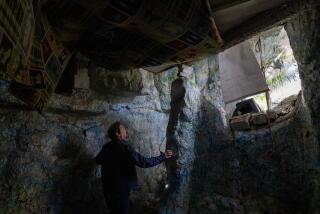Scientists fear an L.A. County gated community’s environmental impact
A Texas developer and a group of California scientists are feuding over the amount of environmental damage a gated community would bring to one of the last remaining parcels of prime wildlife habitat in the southern Santa Susana Mountains.
“This isn’t just about adding another bunch of expensive homes in the foothills,” said Sean Anderson, director of California State Channel Islands’ Pacific Institute for Restoration Ecology and one of 17 scientists who have signed a petition opposed to the project. “It’s about an amoeba-like tendril of development” that would absorb vital wildlife habitat.
The scientists question whether the Los Angeles City Planning Commission, which is scheduled to vote on certification of the Hidden Creeks Estates’ environmental impact report Thursday, has adequately considered the biological consequences of grading 6.5 million cubic yards of earth, removing 456 trees and building 188 homes in the realm of black bears, mountain lions, garter snakes and endangered California condors.
The site is now in unincorporated Los Angeles County but is proposed for annexation by Los Angeles as part of the adjacent affluent community of Porter Ranch, which supports the development. The land is zoned for 33 homes, but the developer hopes to increase that to 188 under the city jurisdiction.
The property lies in the north San Fernando Valley between Brown’s and Mormon creeks, the only perennial creeks in the southern Santa Susanas. It abuts the 2,326-acre Michael D. Antonovich Regional Park and about 10,000 acres of open space managed by the Mountains Recreation and Conservation Authority, a local government agency.
Forestar Real Estate Group, Inc., of Austin, Texas, plans to price the homes at $850,000 to $1.5 million. Forestar says the project, perched in idyllic seclusion on a plateau, would benefit all Los Angeles by including a 19-acre public park, a 122-acre nature preserve, 2.5 miles of hiking and riding trails, and a 1-million-gallon water tank for firefighting purposes. The company would also plant four trees for each tree removed.
“We are aware that the property has valuable resources and the community plan was designed specifically to minimize impacts on, and to protect, these resources and wildlife areas,” said Michael Sanders, a spokesman for the developer. “While there may be few pristine places in the city of Los Angeles, Hidden Creeks provides an important balance between stimulating the economy, providing public benefits and remaining environmentally sensitive.”
Sanders also said the homesites would be clustered on an area that is not pristine. It has been “highly disturbed” by ranching and filming operations over the years, he said.
Scientists from UCLA, USC, Humboldt State, Cal State Northridge, Loyola Marymount University and Santa Monica College, say Forestar is missing the point.
“To suggest the region and its wildlife will be better off and safer after this high-end gated community gets built is preposterous,” said Travis Longcore, an associate adjunct professor at UCLA’s Institute of the Environment and Sustainability.
Paula Schiffman, a professor of biology at Cal State Northridge, said, “The developer calls this area ‘highly disturbed,’ but I see nesting materials, native sage and sunflowers, hiding places for ring-necked snakes and foraging grounds for bobcats and white-tailed kites.”
Ambling recently along a shady stretch of trail on the eastern edge of the site, Schiffman said the area is home to “a vibrant and diverse web of life that should be set aside as one of the city’s important natural assets — not another housing development.”
Paul Edelman, deputy director of natural resources for the Santa Monica Mountains Conservancy, said the site “is a critical component of the Santa Susana ecosystem. You couldn’t pick an ecologically worse place to plop down a big subdivision.”
Entry into the development would be via a 3/4 -mile-long extension to Mason Avenue constructed by the developer. The road would require cutting a 180-foot-deep path through a ridgeline blanketed with coastal sage scrub habitat.
More to Read
Start your day right
Sign up for Essential California for news, features and recommendations from the L.A. Times and beyond in your inbox six days a week.
You may occasionally receive promotional content from the Los Angeles Times.







